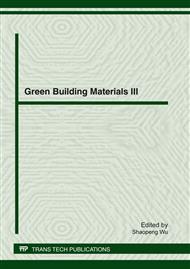p.1
p.6
p.13
p.20
p.26
p.33
p.40
p.45
p.51
Improvement on the Crack Resistance Property of Semi-Flexible Pavement by Cement-Emulsified Asphalt Mortar
Abstract:
Semi-flexible pavement (SFP) has some excellent characteristic such as high carrying capacity, good wearing resistance, water stability and durability. However, the SFP appears low temperature crack and fatigue cracking seriously because there are large differences in the interfacial bonding property and the elastic modules between its two major parts: Lag gap asphalt mixture (LGAM) and cement mortar. All of these are caused by the large stiffness of cement mortar. In order to improve the crack resistance property of SFP, six kinds of cement-emulsified asphalt mortars (CEAM) were developed to enhance the adhesive property and reduce the elastic modules. The cement-emulsified asphalt mortar semi-flexible pavement material (CEAMSFP) was obtained by using this kind of CEAM. In the CEAM and the CEAMSFP, six emulsified asphalt-to-cement (A/C) ratios were considered in the study: 0, 0.1, 0.2, 0.3, 0.4 and 0.5 by weight of emulsified asphalt. The results indicated that the increasing of the A/C ratio improved the bonding interface and the flexible of the CEAM. The increasing of the A/C ratio improved the low temperature resistance and fatigue life of the CEAMSFP. It was also shown that the A/C ratio of 0.3 was found to be the optimum ratio that achieved a balance in performance and the value of the pavement. In this condition, the adhesion level between LGAM and cement grout reached 5,the elastic modules of mortar decreased by 62.5% and the fatigue life of SFP increased by 43.6%.
Info:
Periodical:
Pages:
26-32
Citation:
Online since:
April 2012
Authors:
Price:
Сopyright:
© 2012 Trans Tech Publications Ltd. All Rights Reserved
Share:
Citation:


